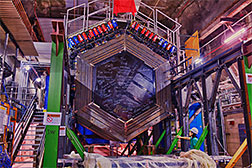- Number 400 |
- November 4, 2013
Neutrino experiment reveals surprising behavior inside heavy nuclei

The MINERvA neutrino experiment at
Fermilab. Credit: Fermilab
A new measurement by the MINERvA collaboration at DOE’s Fermi National Accelerator Laboratory shows that current predictions of how protons and neutrons behave inside heavy nuclei are not accurate.
The MINERvA experiment uses neutrinos to look at the interior of nuclei. Surprisingly, the scientists found that the nucleons inside heavy nuclei behave differently from what one would predict from measurements using electrons to peek inside those same nuclei.
The standard model predicts precisely how a neutrino interacts with a single quark inside a proton or neutron. Using a high-energy neutrino beam provided by Fermilab’s accelerator complex, the MINERvA scientists bombarded various types of nuclei with neutrinos and gathered neutrino cross section data for carbon, iron, lead and plastic. The measurements showed that the heavier the nucleus, the more the data do not agree with standard predictions. The results indicate that the quarks inside heavier nuclei have extra momentum, which they somehow must acquire due to interactions with quarks inside the entire nucleus, not just within a single nucleon.
This phenomenon needs to be taken into account in simulations of nuclei for future high-precision neutrino experiments, including measurements of neutrino oscillations.[Kurt Riesselmann, 630.840.3351,
media@fnal.gov]
